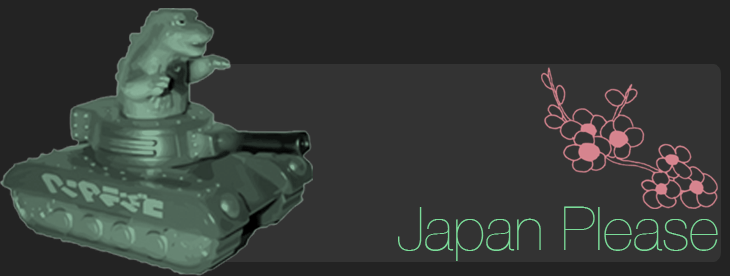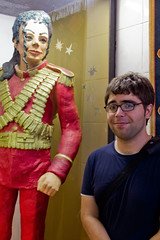Slapped together a clip reel....
Saturday, December 10, 2011
Saturday, November 5, 2011
Budapest, Prague, and Vienna
We've slacked on the blog updates. Sorry. Europe was so much more expensive and easy to travel than the Asia portion of our journey that we pretty much sped through the continent. I suppose we'll be speeding a bit through the blog posts as well. When last we met, we had survived radioactive moss and possible wild boar attacks in Chernobyl. Our next destination was decidedly more tame: Budapest, Hungary.
Another overnight train brought us into the city. The city itself is gorgeous. It's always being called the Little Paris of of Central Europe, but at this point I think it's actually more beautiful and cleaner than a lot of Paris itself. On our first day, we went to the Hungarian Museum of Agriculture. It's housed in a former castle, which made the building more interesting than many of the exhibits. In the afternoon, we caught a train to the nearby town of Szentendre to check out a marzipan museum. It had and amazing variety of huge marzipan sculptures, with everything from Teenage Mutant Ninja Turtles to a life-sized Princess Diana.
Another overnight train brought us into the city. The city itself is gorgeous. It's always being called the Little Paris of of Central Europe, but at this point I think it's actually more beautiful and cleaner than a lot of Paris itself. On our first day, we went to the Hungarian Museum of Agriculture. It's housed in a former castle, which made the building more interesting than many of the exhibits. In the afternoon, we caught a train to the nearby town of Szentendre to check out a marzipan museum. It had and amazing variety of huge marzipan sculptures, with everything from Teenage Mutant Ninja Turtles to a life-sized Princess Diana.
The star exhibit was the giant Michael Jackson, seen here threatening Greg. The sculpture was so popular that they were actually in the process of making a second when we were there.
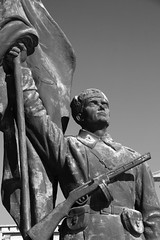
The following day we headed to Monument Park, a sort of graveyard for old soviet statues. The park was a bit overpriced and had far fewer exhibits than I was expecting. More interesting than the statues was an old East German made car called a Trabant. Its loud two stroke engine produced about nine times the pollution of its western counterparts, and buyers often had to put up money for the car years before they would actually receive it.
We also checked out the Saturday flea market. It had some really wonderful stuff, but, alas, nothing small and light enough that I could justify hauling it around in my backpack the remainder of the trip.
While the tourist attractions themselves weren't too exciting, Budapest was still a wonderful city to visit. It's very pleasant to walk, it has a very nice streetcar system, people were always happy to speak English (because Hungarian is basically impossible to learn), and we had some of the most amazing and certainly the largest meals of the whole trip there. The food we ate seemed to mostly consist of large quantities of already fattening things breaded and deep fried. Also paprika.
Another overnight train trip (during which we managed to sleep through the entire country of Slovakia) landed us in Prague. In Prague we found that we didn't eat all that much. I think we were still recovering from Hungary.

I had been to Prague once before back in 2004, so this was the first city that was a repeat visit for me. It was just as beautiful as last time, but far busier. The old town area was absolutely packed with tourists. This was the first city in which we started to encounter a lot of Americans again. I took Greg on the basic tour: old town square, the Jewish cemetery, the Charles Bridge, Prague castle, and Strahov monastery. At the monastery we visited the Museum of Miniatures. It had amazing tiny works of art viewable only by microscope. You could look at a hair with your eye and see nothing, but through the microscope you'd see an entire menagerie of carefully sculpted animals sitting on the hair.


The following day we headed to Monument Park, a sort of graveyard for old soviet statues. The park was a bit overpriced and had far fewer exhibits than I was expecting. More interesting than the statues was an old East German made car called a Trabant. Its loud two stroke engine produced about nine times the pollution of its western counterparts, and buyers often had to put up money for the car years before they would actually receive it.
We also checked out the Saturday flea market. It had some really wonderful stuff, but, alas, nothing small and light enough that I could justify hauling it around in my backpack the remainder of the trip.
While the tourist attractions themselves weren't too exciting, Budapest was still a wonderful city to visit. It's very pleasant to walk, it has a very nice streetcar system, people were always happy to speak English (because Hungarian is basically impossible to learn), and we had some of the most amazing and certainly the largest meals of the whole trip there. The food we ate seemed to mostly consist of large quantities of already fattening things breaded and deep fried. Also paprika.
Another overnight train trip (during which we managed to sleep through the entire country of Slovakia) landed us in Prague. In Prague we found that we didn't eat all that much. I think we were still recovering from Hungary.

I had been to Prague once before back in 2004, so this was the first city that was a repeat visit for me. It was just as beautiful as last time, but far busier. The old town area was absolutely packed with tourists. This was the first city in which we started to encounter a lot of Americans again. I took Greg on the basic tour: old town square, the Jewish cemetery, the Charles Bridge, Prague castle, and Strahov monastery. At the monastery we visited the Museum of Miniatures. It had amazing tiny works of art viewable only by microscope. You could look at a hair with your eye and see nothing, but through the microscope you'd see an entire menagerie of carefully sculpted animals sitting on the hair.

The next day we took a train to Kutna Hora. We wasted about half the day wandering about lost because of some bad information from the internet. We did the whole trip without any paper guide books, which was nice for keeping of the beaten track but occasionally we were led astray. Once we got back on track we easily found Sedlec Ossuary, the famous bone church. The basic story is that the cemetery got too full and they let an eccentric do what he wanted with the bones to make room. Highlights included a chandelier and a coat of arms.
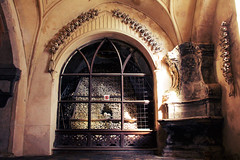

Before heading down to Austria, we dropped into a Lego museum. It was mostly devoted to pre-made Lego kits rather than creative original designs, which was a bit disappointing, but still made for a good nostalgia trip.
Vienna is not a cheap city, so we booked a room outside of the tourist area, but still near the subway. We were shocked to find that our room was actually an apartment, complete with a kitchen and a shower. Vienna has an awesome old street car system that made traveling to attractions an attraction in itself.
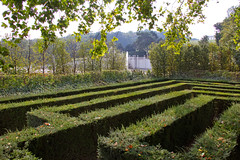
We first visited Schloss Schonbrunn Palace, but declined to go inside because places themselves aren't really our thing. Instead we headed to the back, where they have fun interactive sculptures and a hedge maze.

Next up was the Narrenturm. This giant circular building used to be an insane asylum. Now the creepy old cells that housed patients contain thoroughly disturbing medical exhibits as part of an anatomy museum. If you've ever wanted to see wax models of STD infected skin and giant skulled skeletons in glass cases while walking in a dizzying, seemingly unending circle, this is the place for you!
The following day we visited the Austrian National Library, which looks exactly like a library should. Then we headed up to an amusement park to see the Ferris Wheel made famous in The Third Man. The wheel cost about ten bucks to ride, so we declined and headed for the world's tallest swing ride, which was just around the corner. We finished off the day by visiting Sigmund Freud's old apartment, where you can see his famous fainting couch among other things.

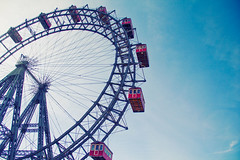
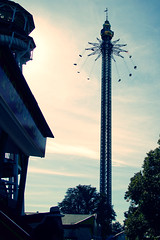


Before heading down to Austria, we dropped into a Lego museum. It was mostly devoted to pre-made Lego kits rather than creative original designs, which was a bit disappointing, but still made for a good nostalgia trip.
Vienna is not a cheap city, so we booked a room outside of the tourist area, but still near the subway. We were shocked to find that our room was actually an apartment, complete with a kitchen and a shower. Vienna has an awesome old street car system that made traveling to attractions an attraction in itself.

We first visited Schloss Schonbrunn Palace, but declined to go inside because places themselves aren't really our thing. Instead we headed to the back, where they have fun interactive sculptures and a hedge maze.

Next up was the Narrenturm. This giant circular building used to be an insane asylum. Now the creepy old cells that housed patients contain thoroughly disturbing medical exhibits as part of an anatomy museum. If you've ever wanted to see wax models of STD infected skin and giant skulled skeletons in glass cases while walking in a dizzying, seemingly unending circle, this is the place for you!
The following day we visited the Austrian National Library, which looks exactly like a library should. Then we headed up to an amusement park to see the Ferris Wheel made famous in The Third Man. The wheel cost about ten bucks to ride, so we declined and headed for the world's tallest swing ride, which was just around the corner. We finished off the day by visiting Sigmund Freud's old apartment, where you can see his famous fainting couch among other things.



Wednesday, October 5, 2011
Kiev
A 25 hour train ride carried us from Moscow to Kiev, Ukraine. Kiev was sort of Moscow-lite. The metro was almost identical in design to that of Moscow, but without all the glitz. It was also a bit more English friendly, which made things less intimidating. Furthermore, the prices were actually reasonable.
Our hostel was immediately next to independence square. We were stuck in a completely packed 10 bed dorm room, apparently because every room in town was occupied for a major dance competition taking place about a hundred feet away from us.
Our first night we grabbed some sandwiches and headed toward the Dnieper River to have a picnic dinner. We were surprised to find ourselves with lots of company, as we ended up in a former soviet outdoor theater that had been converted into a small amusement park. We watched teenagers climb on the tops of heads of imposing soviet statues while Matrix-themed thrill rides spun in the background.
One of my stranger life long goals has been to explore Chernobyl, so when we found out that our hostel could connect us with a guide who could bring us into the exclusion zone signed up immediately.
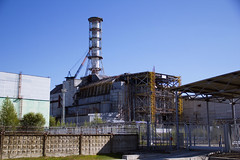
We were loaded into a van where we ended up seated next to two Japanese guys. We were pretty tired so we let them chat for about an hour before they began contemplate where we were from and we chimed in with a Japanese response. One of them was from the area near the Fukushima plant, so he was especially interested in seeing how the government reacted to the disaster.
We watched a video explaining the basics of the disaster. It was the first time I had heard the phrase "bio-robot." Apparently actual robots weren't getting the job of shoveling highly radioactive rubble off the roof of the plant done quickly enough, so the government had soldiers sew together their own lead bibs and run onto the roof for twenty second shifts.
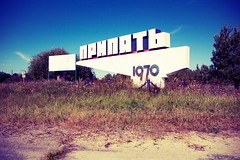
Finally arriving at the exclusion zone, you have to pass through a security check before attending a meeting where you sign off on your life in a waver and get told not to touch or sit on anything. Then we were brought into Pripyat, the worker's town. Two days after the disaster, 53,000 people were told they needed to evacuate for three days, but then they were never allowed to return.
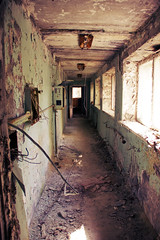
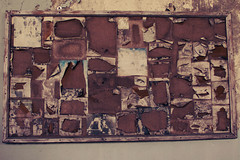
The preferred method of evacuation was to break windows and throw out your belongings. You more often find yourself stepping on broken glass or books than actual floor. Nature has made its way back into the buildings.
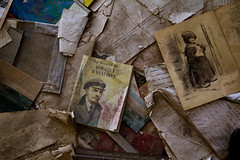
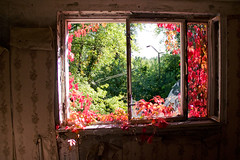
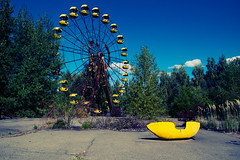
The amusement park was scheduled to open a few days after the evacuation.
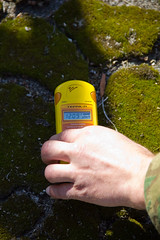
This moss is registering at 12 micro sieverts - the equivalent of about two and a half dental x-rays.
I was pleasantly surprised by how much freedom we were given to explore the town. At the school, we were simply told to "come back in twenty minutes." I got so wrapped up in taking pictures that I got completely lost and had to run through the hallways trying to find an exit.

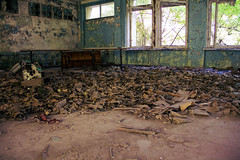
On the way out, we had to pass through a machine that allegedly told us if we were covered in radiation or not. I'm not entirely convinced the machine did anything more than flash a green light every time a person stood on it. To this day the government only acknowledges the deaths of the 31 workers who died immediately, but Greenpeace estimates that 200,000 or more people have probably died early from cancer as a result of the disaster.
We had two more days in Kiev due to a lack of space on trains. We went to some churches and markets, but I came down with a slight cold and was too tired to do a whole lot. I used it as an excuse to spend some time going through all my Chernobyl photos!
Our hostel was immediately next to independence square. We were stuck in a completely packed 10 bed dorm room, apparently because every room in town was occupied for a major dance competition taking place about a hundred feet away from us.
Our first night we grabbed some sandwiches and headed toward the Dnieper River to have a picnic dinner. We were surprised to find ourselves with lots of company, as we ended up in a former soviet outdoor theater that had been converted into a small amusement park. We watched teenagers climb on the tops of heads of imposing soviet statues while Matrix-themed thrill rides spun in the background.
One of my stranger life long goals has been to explore Chernobyl, so when we found out that our hostel could connect us with a guide who could bring us into the exclusion zone signed up immediately.

We were loaded into a van where we ended up seated next to two Japanese guys. We were pretty tired so we let them chat for about an hour before they began contemplate where we were from and we chimed in with a Japanese response. One of them was from the area near the Fukushima plant, so he was especially interested in seeing how the government reacted to the disaster.
We watched a video explaining the basics of the disaster. It was the first time I had heard the phrase "bio-robot." Apparently actual robots weren't getting the job of shoveling highly radioactive rubble off the roof of the plant done quickly enough, so the government had soldiers sew together their own lead bibs and run onto the roof for twenty second shifts.

Finally arriving at the exclusion zone, you have to pass through a security check before attending a meeting where you sign off on your life in a waver and get told not to touch or sit on anything. Then we were brought into Pripyat, the worker's town. Two days after the disaster, 53,000 people were told they needed to evacuate for three days, but then they were never allowed to return.


The preferred method of evacuation was to break windows and throw out your belongings. You more often find yourself stepping on broken glass or books than actual floor. Nature has made its way back into the buildings.



The amusement park was scheduled to open a few days after the evacuation.

This moss is registering at 12 micro sieverts - the equivalent of about two and a half dental x-rays.
I was pleasantly surprised by how much freedom we were given to explore the town. At the school, we were simply told to "come back in twenty minutes." I got so wrapped up in taking pictures that I got completely lost and had to run through the hallways trying to find an exit.


On the way out, we had to pass through a machine that allegedly told us if we were covered in radiation or not. I'm not entirely convinced the machine did anything more than flash a green light every time a person stood on it. To this day the government only acknowledges the deaths of the 31 workers who died immediately, but Greenpeace estimates that 200,000 or more people have probably died early from cancer as a result of the disaster.
We had two more days in Kiev due to a lack of space on trains. We went to some churches and markets, but I came down with a slight cold and was too tired to do a whole lot. I used it as an excuse to spend some time going through all my Chernobyl photos!
Saturday, October 1, 2011
Moscow
Four straight days on a train can kinda get to you after a while. I didn't feel completely terrible, but when the closest thing to a hot shower is throwing cupfuls of warm water onto your head inside a cramped, bouncing restroom and your only food consists of cereal, bread, and instant noodles, you enter this weird, grimy altered state that you're not fully aware of until days later.
This time, our train was mostly occupied by Mongolian traders, who use their cabins as makeshift warehouses to house cheap jeans, hats, track pants, jackets, and purses. At each major stop, a mad horde of Russian shoppers will come to the train station simply to buy up dirt-cheap Mongolian merchandise on the platform, then go home.
Apart from looking out our window to endless forests, innumerable little wood shack cottages, and the pristine waters of Lake Baikal, we mostly passed the time by playing games, watching movies and TV on Andrea's computer, and hunting for the few-and-far-between power outlets on the train. Half of them didn't work at all, some required bribing the carriage attendant, and the rest almost always had somebody else's cell phone plugged into them. I finally found an open one, and while sitting waiting for my stuff to charge, this little Mongolian kid walks up to me, grabs my iPod touch out of my hand, and proceeds to try out every single game and app for the next 45 minutes. He occasionally asks for help when he can't figure a game out. I was captive, as I needed the charge and didn't feel comfortable just leaving it there.
Finally, we pull into Moscow. With a population of 11 million, it was by far the largest city we had visited, and the most European. I was picturing endless gray apartment blocks encircling the Kremlin, but was pleasantly surprised by its rich, varied architectural styles and (usually) modern infrastructure and amenities. Most impressive of all was the Metro, which consisted of rickety old 1940s trains surrounded tunnels carved out of pure marble and decorated with bronze statues and fancy paintings everywhere, deep underground, with escalators that sometimes take 2 and a half minutes to reach the platform from the surface. Stalin clearly spared no expense, as each station resembled an art museum or sculpture park. Too bad he made the rest of the Eastern bloc so butt-ugly!
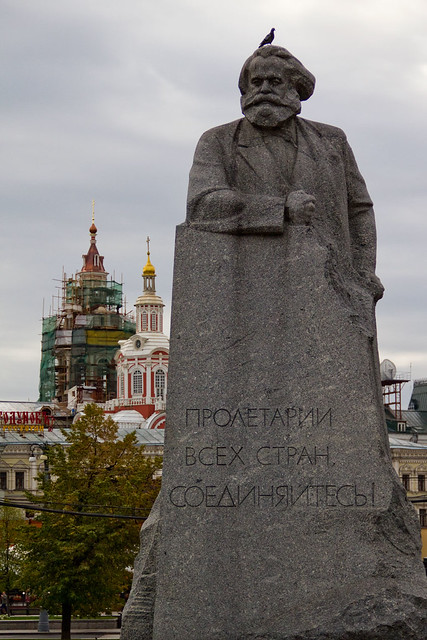
Speaking of costliness, Moscow is not a cheap place. It makes Tokyo look reasonably priced by comparison. The cheapest black Starbucks coffee goes for 6 US dollars, and flavored drinks are even higher. Despite high poverty rates, the city also has the highest concentration of billionaires in the world. The whole city had this weird mixture of scummy cheapness alongside Ferrari dealerships and luxury watch stores.
It's also the least tourist-friendly big city I've ever been to. If you can't read the Cyrillic alphabet, you're completely lost; most signage is exclusively in Russian, even on public transport. I know no Russian but can read enough of the alphabet to get by, so we were never completely lost, but the act of simply figuring out where you are and where you're going can be pretty frustrating.

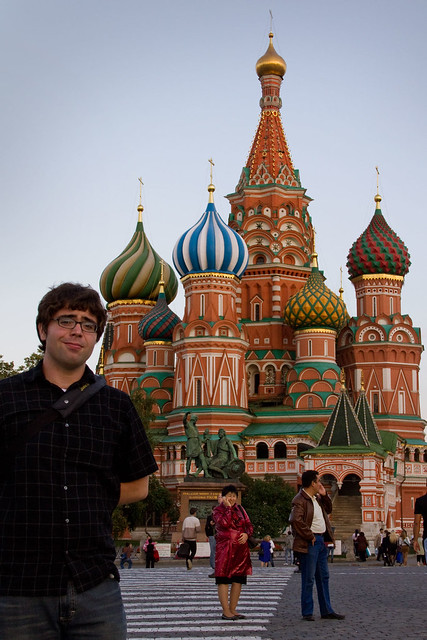
Our first day was devoted to a personal walking tour, led by a pleasant Russian lady who showed us around Red Square, the Kremlin, and the Cathedral of Christ the Savior. I was excited to see the iconic St. Basil's Cathedral, which I had previously seen only in photos and on the title screen of Tetris.
Our guide told us about growing up in Moscow in the era of Khruschev and Brezhnev, and told us that the huge, impressive reconstruction of the Cathedral was the site as a large public swimming pool when she was a kid.

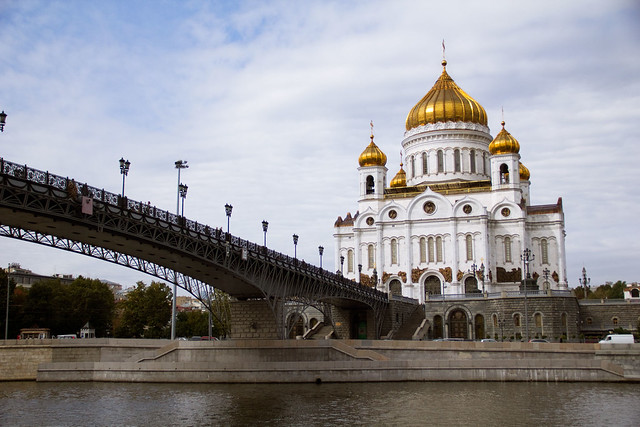
The next day we spent going to some interesting specialty tourist sites that we'd been looking forward to for a while. First up was the Cosmonaut museum, devoted to the history of the Soviet space program, which included a full-size reproduction of Mir that you can enter. After that, we found the Soviet Arcade museum, which housed some hilariously primitive (and occasionally fun) ripoffs of the American and Japanese games of the 70s and 80s. My favorites were the submarine games that used a combination of scale models and light guns through a little periscope. We also had fun with a basketball game that consisted of about 16 hexagonal holes, requiring you to push the correct numbered button to shoot the ball toward your opponent's basket.

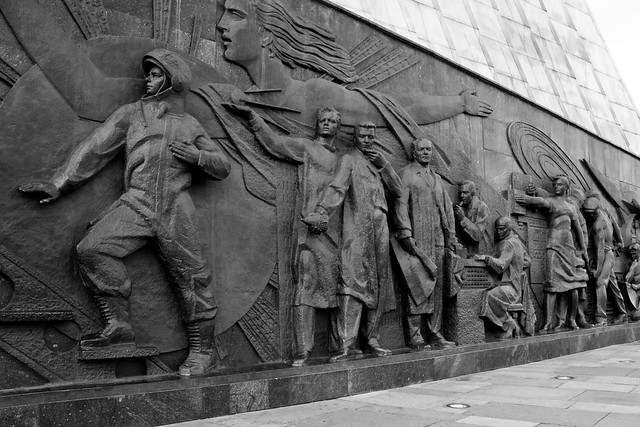
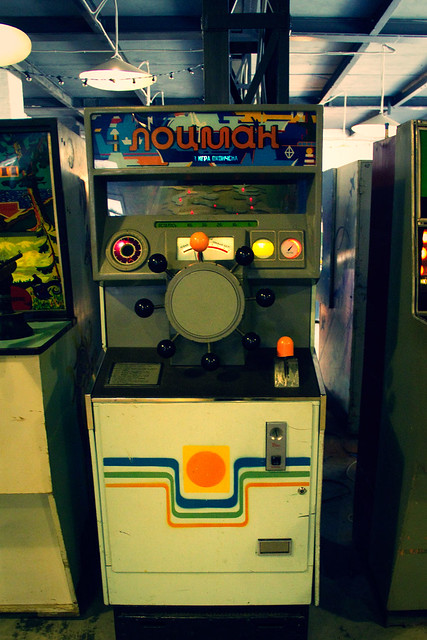
Owing to restrictive Russian visa rules, we had only one more day, which we opted to spend at Gorky Park. The park itself was pleasant enough, if mostly unremarkable, but it had this peculiar kiddie area with some really strange attractions. My favorite was this, a spinning chicken spitting out plastic eggs that you're supposed to catch with a net. The best part was the music it played, which was this demented version of Old MacDonald that will stick in your head forever if you hear it even once. This bizarre carnival game lifted my spirits greatly after a disappointing visit to a Statue Park that ended up being a waste of time.
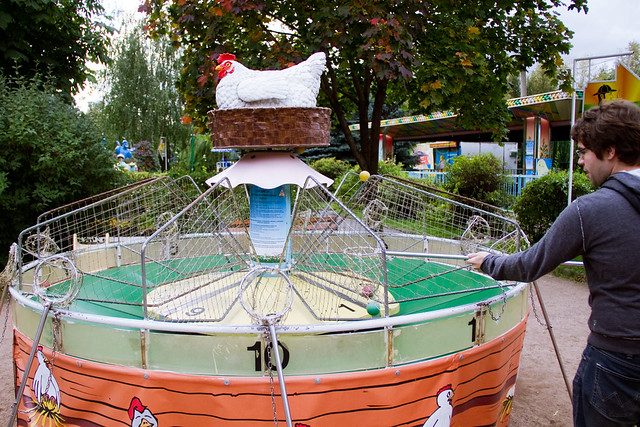
Moscow is a very cool city, but it has this intimidating quality that makes exploring it for a couple days feel a little like you got your ass kicked in a bar fight. I feel like we only scratched the surface, so I do think I'd like to return one day, as well as see other places in Russia we didn't have time for, like St. Petersburg. Hopefully, next time, the Visa won't be so expensive, or require filling out an incomprehensible form with questions asking if I've ever operated a nuclear device or have had weapons training, or basically asking me to list every school I've ever attended in my life.
This time, our train was mostly occupied by Mongolian traders, who use their cabins as makeshift warehouses to house cheap jeans, hats, track pants, jackets, and purses. At each major stop, a mad horde of Russian shoppers will come to the train station simply to buy up dirt-cheap Mongolian merchandise on the platform, then go home.
Apart from looking out our window to endless forests, innumerable little wood shack cottages, and the pristine waters of Lake Baikal, we mostly passed the time by playing games, watching movies and TV on Andrea's computer, and hunting for the few-and-far-between power outlets on the train. Half of them didn't work at all, some required bribing the carriage attendant, and the rest almost always had somebody else's cell phone plugged into them. I finally found an open one, and while sitting waiting for my stuff to charge, this little Mongolian kid walks up to me, grabs my iPod touch out of my hand, and proceeds to try out every single game and app for the next 45 minutes. He occasionally asks for help when he can't figure a game out. I was captive, as I needed the charge and didn't feel comfortable just leaving it there.
Finally, we pull into Moscow. With a population of 11 million, it was by far the largest city we had visited, and the most European. I was picturing endless gray apartment blocks encircling the Kremlin, but was pleasantly surprised by its rich, varied architectural styles and (usually) modern infrastructure and amenities. Most impressive of all was the Metro, which consisted of rickety old 1940s trains surrounded tunnels carved out of pure marble and decorated with bronze statues and fancy paintings everywhere, deep underground, with escalators that sometimes take 2 and a half minutes to reach the platform from the surface. Stalin clearly spared no expense, as each station resembled an art museum or sculpture park. Too bad he made the rest of the Eastern bloc so butt-ugly!

Speaking of costliness, Moscow is not a cheap place. It makes Tokyo look reasonably priced by comparison. The cheapest black Starbucks coffee goes for 6 US dollars, and flavored drinks are even higher. Despite high poverty rates, the city also has the highest concentration of billionaires in the world. The whole city had this weird mixture of scummy cheapness alongside Ferrari dealerships and luxury watch stores.
It's also the least tourist-friendly big city I've ever been to. If you can't read the Cyrillic alphabet, you're completely lost; most signage is exclusively in Russian, even on public transport. I know no Russian but can read enough of the alphabet to get by, so we were never completely lost, but the act of simply figuring out where you are and where you're going can be pretty frustrating.


Our first day was devoted to a personal walking tour, led by a pleasant Russian lady who showed us around Red Square, the Kremlin, and the Cathedral of Christ the Savior. I was excited to see the iconic St. Basil's Cathedral, which I had previously seen only in photos and on the title screen of Tetris.
Our guide told us about growing up in Moscow in the era of Khruschev and Brezhnev, and told us that the huge, impressive reconstruction of the Cathedral was the site as a large public swimming pool when she was a kid.


The next day we spent going to some interesting specialty tourist sites that we'd been looking forward to for a while. First up was the Cosmonaut museum, devoted to the history of the Soviet space program, which included a full-size reproduction of Mir that you can enter. After that, we found the Soviet Arcade museum, which housed some hilariously primitive (and occasionally fun) ripoffs of the American and Japanese games of the 70s and 80s. My favorites were the submarine games that used a combination of scale models and light guns through a little periscope. We also had fun with a basketball game that consisted of about 16 hexagonal holes, requiring you to push the correct numbered button to shoot the ball toward your opponent's basket.



Owing to restrictive Russian visa rules, we had only one more day, which we opted to spend at Gorky Park. The park itself was pleasant enough, if mostly unremarkable, but it had this peculiar kiddie area with some really strange attractions. My favorite was this, a spinning chicken spitting out plastic eggs that you're supposed to catch with a net. The best part was the music it played, which was this demented version of Old MacDonald that will stick in your head forever if you hear it even once. This bizarre carnival game lifted my spirits greatly after a disappointing visit to a Statue Park that ended up being a waste of time.

Moscow is a very cool city, but it has this intimidating quality that makes exploring it for a couple days feel a little like you got your ass kicked in a bar fight. I feel like we only scratched the surface, so I do think I'd like to return one day, as well as see other places in Russia we didn't have time for, like St. Petersburg. Hopefully, next time, the Visa won't be so expensive, or require filling out an incomprehensible form with questions asking if I've ever operated a nuclear device or have had weapons training, or basically asking me to list every school I've ever attended in my life.
Sunday, September 18, 2011
The Ghengis Khan-Khan: How we hitchhiked and slept in a stranger's tent house all without dying!
The first leg of our Trans-Siberian journey was an overnight train from Beijing to Ulaanbaatar. The train was clean and modern (we even had a power outlet in our room!) and the top bunks never filled up so we had the whole cabin to ourselves. The only exhausting part of the journey was the extremely long stop at the border. China's tracks are a different gauge than those of Mongolia, so we didn't get to sleep until around 2 am after waiting for the wheels to change (in addition to the usual tedious immigration procedures).
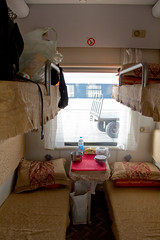
Arriving in Ulaanbaatar, our initial impression was that it was freezing. We had only long underwear and sweatshirts for warmth because we weren't expecting 36*F temperatures in September, but apparently that's the norm. The city basically has one main road that everything interesting is either on or next to, so traffic on this road is some of the slowest moving I've ever seen.
Mongolia is famously unfriendly to vegetarians, but vegetarian restaurants have become surprisingly trendy in the capital city. There were five Loving Huts alone!
On our second day, we decided to head to Gorki-Terelj National park, just a two hour bus ride from Ulaanbaatar. We hadn't realized the public bus would be filled to the brim for most of the journey, and Greg spent the whole ride leaning on an armrest. The description of the park we got online told us that there are tourist ger (Mongolian nomadic tent house) camps leading up to the town of Terelj. What we didn't realize was that our bus went the opposite direction, starting in Terelj and going through the park before heading back to the city. So basically we missed our stop. Alarmed, we decided to get off at what we thought might be a tourist camp. It was not. This was where we started to panic, remembering that there's only one bus a day.
It was just moments later that we noticed somebody else, a Mongolian woman in a traditional outfit, had also exited the bus. She must have observed our panicked looks because she quickly waved us over to follow her. We descend a hill and go through some trees before arriving at her family compound, all the while shooting each other looks of "what the heck are we doing?" Our Mongolian is as good as her English, which is to say we have no way of communicating. We pass a small house and some horses before arriving at a ger. She shoos out two people who I think are her daughter and her daughter's boyfriend before waving us in and pointing at the beds. We shrug and hand her some cash for her hospitality.

As we get settled in our toasty little tent and figure out how to load the stove, we marvel at how weird this whole situation is. Then there's a knock at the door. The daughter is there.
"日本語わかりますか?”("Do you understand Japanese?") she asks.
Without much thinking I reply in the affirmative. She explains that she forgot her mirror and we invite her in. It isn't until she leaves that we realize how much weirder this whole situation just got. Not only does this girl in the middle of nowhere in Mongolia speak Japanese, but she happened to find probably the only two white people for several thousand miles who also know Japanese. How in the world did she know to ask?
It soon got dark and there wasn't much to do. Luckily we brought entertainment. Yes, we watched Bill and Ted's Excellent Adventure on my laptop in a ger in Mongolia. Because, y'know, like, Ghengis Khan's in it so it was, like, totally relevant.

The next day we thanked our host and hiked back up to the road to catch the bus back to town. Greg became fast friends with some of the local dogs along the way. Our bus passed through some gorgeous rock and tree filled sections of the park, but unfortunately we couldn't get any pictures.
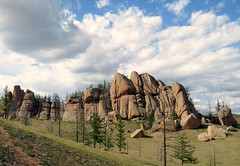
Thanks to the internet, it's ok that I didn't get any photos of my own!
Back in town, we checked into a hostel. We had a personal guided tour through the intellectual museum, which was basically just one wacky guy's display of puzzles he's made and various toys he has collected. When it was time to head back to the train station we decided we didn't want to walk because we had built up a huge collection of food in preparation for several days on the Trans-Siberian railway. There seemed to be no taxis, but one of the hostel employees explained that if you stick your hand out someone will give you a ride. It worked! Surprisingly quickly, too. Two women pulled over and we told them "train station" and then they spent the remainder of the ride completely ignoring our presence. We gave them our leftover Mongolian money we hadn't been able to convert to rubles, and they seemed more than pleased with the amount even though it was less than five dollars.
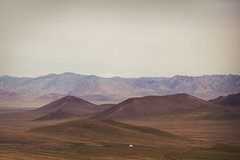
Now I'm typing this on the train to Moscow, which will involve four long, shower-less nights of traveling and eating instant noodles. It's the low season, so most people on the train seem to be Mongolian merchants who get out at each stop to sell cheap track suits to immense hordes of Russian shoppers who apparently gather at the stations just to shop.
Competition for the few working power outlets in here is fierce, so I don't think I can keep a daily log of our cabin fever. I'll just type what a think will happen after my battery dies:
Andrea's Log, Day 5: The weather is nice. I have made a necklace out of Greg's intestines.

Arriving in Ulaanbaatar, our initial impression was that it was freezing. We had only long underwear and sweatshirts for warmth because we weren't expecting 36*F temperatures in September, but apparently that's the norm. The city basically has one main road that everything interesting is either on or next to, so traffic on this road is some of the slowest moving I've ever seen.
Mongolia is famously unfriendly to vegetarians, but vegetarian restaurants have become surprisingly trendy in the capital city. There were five Loving Huts alone!
On our second day, we decided to head to Gorki-Terelj National park, just a two hour bus ride from Ulaanbaatar. We hadn't realized the public bus would be filled to the brim for most of the journey, and Greg spent the whole ride leaning on an armrest. The description of the park we got online told us that there are tourist ger (Mongolian nomadic tent house) camps leading up to the town of Terelj. What we didn't realize was that our bus went the opposite direction, starting in Terelj and going through the park before heading back to the city. So basically we missed our stop. Alarmed, we decided to get off at what we thought might be a tourist camp. It was not. This was where we started to panic, remembering that there's only one bus a day.
It was just moments later that we noticed somebody else, a Mongolian woman in a traditional outfit, had also exited the bus. She must have observed our panicked looks because she quickly waved us over to follow her. We descend a hill and go through some trees before arriving at her family compound, all the while shooting each other looks of "what the heck are we doing?" Our Mongolian is as good as her English, which is to say we have no way of communicating. We pass a small house and some horses before arriving at a ger. She shoos out two people who I think are her daughter and her daughter's boyfriend before waving us in and pointing at the beds. We shrug and hand her some cash for her hospitality.

As we get settled in our toasty little tent and figure out how to load the stove, we marvel at how weird this whole situation is. Then there's a knock at the door. The daughter is there.
"日本語わかりますか?”("Do you understand Japanese?") she asks.
Without much thinking I reply in the affirmative. She explains that she forgot her mirror and we invite her in. It isn't until she leaves that we realize how much weirder this whole situation just got. Not only does this girl in the middle of nowhere in Mongolia speak Japanese, but she happened to find probably the only two white people for several thousand miles who also know Japanese. How in the world did she know to ask?
It soon got dark and there wasn't much to do. Luckily we brought entertainment. Yes, we watched Bill and Ted's Excellent Adventure on my laptop in a ger in Mongolia. Because, y'know, like, Ghengis Khan's in it so it was, like, totally relevant.

The next day we thanked our host and hiked back up to the road to catch the bus back to town. Greg became fast friends with some of the local dogs along the way. Our bus passed through some gorgeous rock and tree filled sections of the park, but unfortunately we couldn't get any pictures.

Thanks to the internet, it's ok that I didn't get any photos of my own!
Back in town, we checked into a hostel. We had a personal guided tour through the intellectual museum, which was basically just one wacky guy's display of puzzles he's made and various toys he has collected. When it was time to head back to the train station we decided we didn't want to walk because we had built up a huge collection of food in preparation for several days on the Trans-Siberian railway. There seemed to be no taxis, but one of the hostel employees explained that if you stick your hand out someone will give you a ride. It worked! Surprisingly quickly, too. Two women pulled over and we told them "train station" and then they spent the remainder of the ride completely ignoring our presence. We gave them our leftover Mongolian money we hadn't been able to convert to rubles, and they seemed more than pleased with the amount even though it was less than five dollars.

Now I'm typing this on the train to Moscow, which will involve four long, shower-less nights of traveling and eating instant noodles. It's the low season, so most people on the train seem to be Mongolian merchants who get out at each stop to sell cheap track suits to immense hordes of Russian shoppers who apparently gather at the stations just to shop.
Competition for the few working power outlets in here is fierce, so I don't think I can keep a daily log of our cabin fever. I'll just type what a think will happen after my battery dies:
Andrea's Log, Day 5: The weather is nice. I have made a necklace out of Greg's intestines.
Saturday, September 17, 2011
China
The Vietnam/China border proved less intimidating than some of our guidebooks had promised. Our train dropped us off at 4 in the morning, so we sat outside on the steps of the Vietnamese customs building until it opened at 7. We heard stories of Chinese border guards rifling through your bags in search of (among other things) travel books whose maps dare to color Taiwan differently from the mainland. Happily, we didn't experience anything like that; one of the guards was even pretty friendly and tried to help us fill out our entry form.
After crossing a weird no-man's-land bridge over a river and passing through customs, your entry point in China is Hekou, which was pretty squalid, albeit more developed than the Vietnamese town across the river. We had a hard time changing our money at banks because it was a Sunday; a helpful young policeman tried to find us a working ATM while practicing his broken English on me, but we were unsuccessful-- you could tell he was pretty bored and was mostly just looking for an excuse to get out of the office.
Finally, we found a guy at the bus station who was not only pretty fluent in English, but was also willing to change our money at what was a decent rate considering he was the only game in town that day. We boarded the bus bound for Kunming, and proceeded to experience 10 hours of driving through some pretty incredible scenery: elevated freeways through steep mountains, supported by impossibly tall columns and winding through endless tunnels. As we got approached Kunming, we came across some bizarre, unearthly rock formations and rows of spherical trees unlike anything I've seen before. It felt like we'd entered another planet after the endless jungles and hills in Vietnam and Cambodia. We later realized that what we were looking at was Kunming's star tourist attraction, the Stone Forest National Park.
Apart from that, Kunming doesn't have much to offer tourists, but the city was pretty incredible to us at the time. I'd never even heard of the place before we started planning the trip, but with a population of 6 million, it was much bigger than any other place we'd been to up to that point. The high elevation and dry climate allowed for mid-August temperatures in the 60s and 70s, a welcome relief from the nonstop sticky heat up until then.
The city center was mostly very clean and modern-- so much so that we almost felt like we were back in Japan. There were lots of genuine high-end retail shops, and a few convincing fake ones, too. We saw two of those imitation Apple stores that have been getting some attention in the West -- I presume they were both just different enough to avoid getting shut down.
Very soon, we discovered a very different language barrier than what we'd experienced before. Vietnamese and Cambodians almost always knew a little English (i.e., just enough to get you to buy something), but the Chinese we dealt with either could speak very well or knew none at all. Having learned some Japanese in our two years living in Kanazawa, we were in the unusual-for-Western-tourists position of being able to read and write some Chinese while having zero listening or speaking ability. This proved very helpful at many points where we could have easily gotten lost, and allowed us to try things we might not have otherwise tried, but the differences between the languages sometimes made for some confusion and frustration.
Our next stop was Chengdu, and our plans to take a sleeper train out of Kunming were foiled by the mad rush of high tourist season. Our knowledge of Chinese characters allowed us to figure out that all train seats on the route we wanted were completely booked for the next 10 days. We ended up finding a company that sold us tickets for a sleeper bus, which did allow us to lay down for the night, but it was cramped, stuffy, and didn't allow you to wear your shoes anywhere inside, even on the floor of the urine-soaked squatter toilet.
Finally in Chengdu, we found another modern, relatively clean city, with hotter temperatures than Kunming, but also with a fantastic subway line that had just opened a year earlier, which clearly had borrowed liberally from the design of Singapore's own modern, efficient metro system. Chengdu is the largest city in Sichuan (also romanized as Szechuan) province; if you've heard of or tried this ultra-spicy brand of southern Chinese cuisine, this province and its capital city are the epicenter.
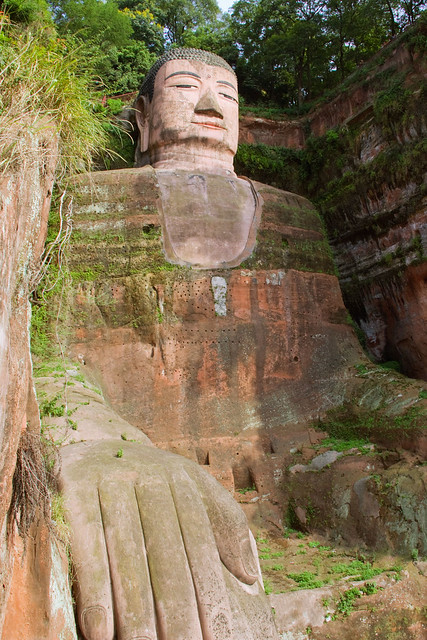
First up on our tourism docket was the Leshan Grand Buddha, the largest carved stone Buddha statue in the world, and, completed in 810 AD, the largest pre-modern statue in the world. With the help of a nice college student who was majoring in English at Chengdu University and happened to be returning home to Leshan on the same bus we were taking, we made it there and back entirely on public transit.
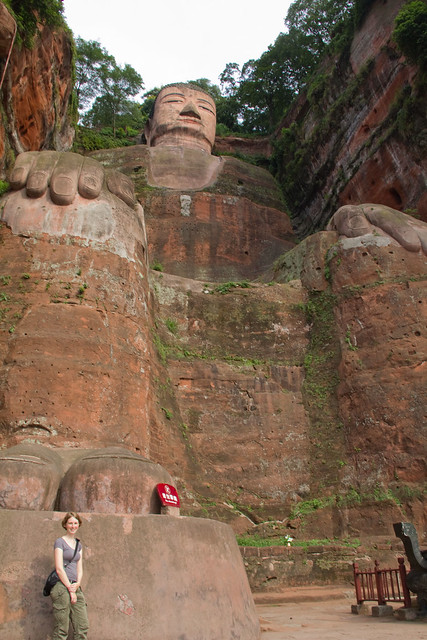
The Grand Buddha is probably the only tourist site on our trip so far that was actually bigger than I had anticipated. It was carved into the side of a mountain at the banks of a river, and required a pretty steep hike down and up to get down to the Buddha's feet, where we took the requisite pictures alongside to give an idea of the full scale of the thing.

Our other big stop in Chengdu was the Panda Research Center, where we met a fellow American, a Vermonter named Alex who is living in China and speaks the language pretty well, much to our benefit. The center had 4 or 5 red pandas, who were playing and scurrying outside, and perhaps a dozen Giant pandas, who dislike the heat so much that they prefer to laze about in the cramped (but air-conditioned) indoors in the summer, despite the enormous outdoor enclosures they had access to.
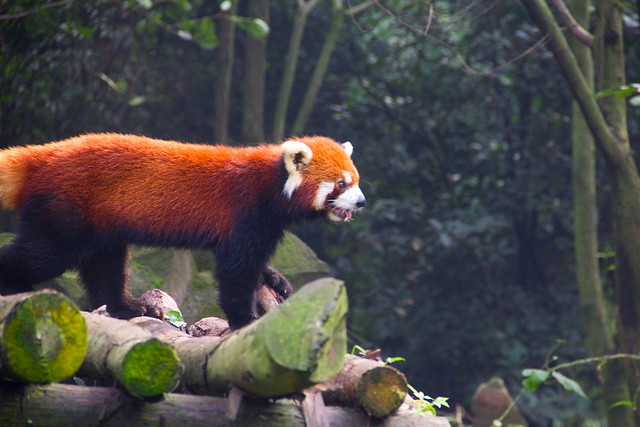
The most memorable sight was the dozen or so baby pandas, all born in the past three weeks, who were being kept in incubators to ensure their survival in the tough early months. We weren't allowed to take pictures of these guys, and it's just as well, because as infants they resemble shaved molerats and had a few more months before they grew enough hair to become recognizably panda-like.
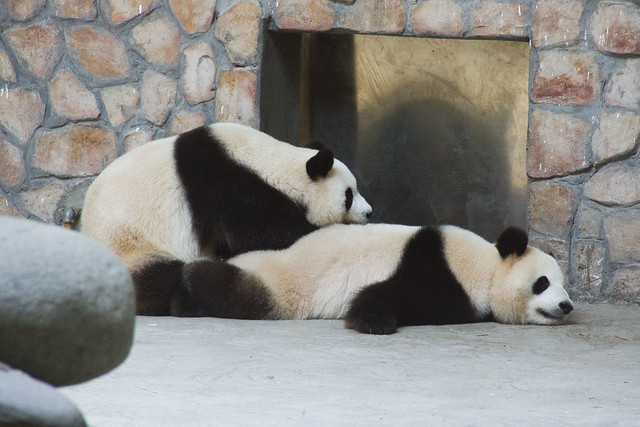
After Chengdu, we were stuck with another bus ride to Xian, during which a very stern lady attendant vigorously enforced the no-smoking policy with what amounted to a public shaming (which didn't stop the same guy from trying to light up two more times during the night, each time resulting in the lights being turned on and a few more minutes of arguing). Xian was a lot more like the China I was originally expecting-- hot, loud, dirty, congested, and (less expected) unrelentingly dusty, so much so that we came back caked in a layer of dust every time we ventured outside our hostel.

Xian was our base point for seeing the Terracotta Army. Our experience there was a little anticlimactic; not knowing any better, we first entered the first of three buildings, which contained the iconic pits with hundreds of warriors lined up. It was pretty big, but nowhere near what we'd imagined, so we figured the other two buildings had something more impressive. Wrong! Those were mostly just huge empty pits they'd already removed the soldiers from. Apparently the excavation is ongoing-- check back in a few years and they'll have a lot more soldiers lined up.

We were finally able to secure a sleeper train for our trip to Beijing, but it required us to spend three extra nights in Xian, whose dirt, heat, and grime started to wear out their welcome. Our 100+ year old hostel was nice enough, but apart from a dollar store with some hilarious knock-off products ("Horseman" razors, modeled after Gillette, and not Crest, but "Craot" toothpaste), Xian didn't have much going for it besides terrible air quality, horribly congested traffic, and a still-incomplete subway that was months away from being usable.
Finally, we got on the nicest non-Japanese train we'd ridden thus far, and arrived the next morning in Beijing, a city whose municipality is roughly the size of Belgium, and as such would be underserved by the descriptor "sprawling". The city center is served by an excellent (if at times inconveniently located) subway system that connected our hostel's area, a cute neighborhood centered around a large Buddhist temple, and the city's main shopping and business districts.
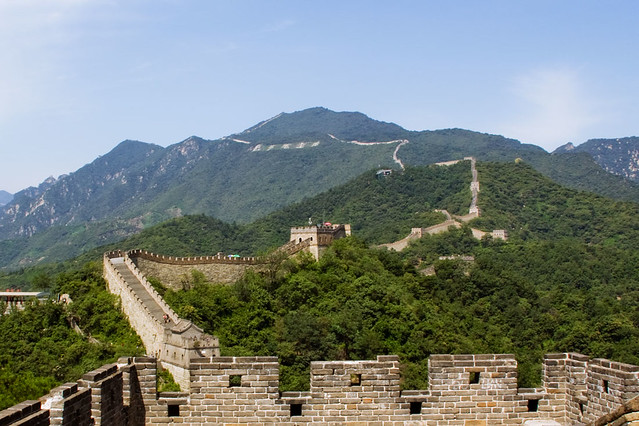
Our first full day was spent on a Great Wall excursion. The section we went to was slightly less packed with tourists and vendors than the famed section that Nixon (among others) had been photographed at. It did, however, boast a ski-style chairlift up to the steep mountaintop where the wall was located, and an exceedingly fun slide down the hill, where you pilot a little plastic seat with wheels and a single lever that functioned as both brake and accelerator.
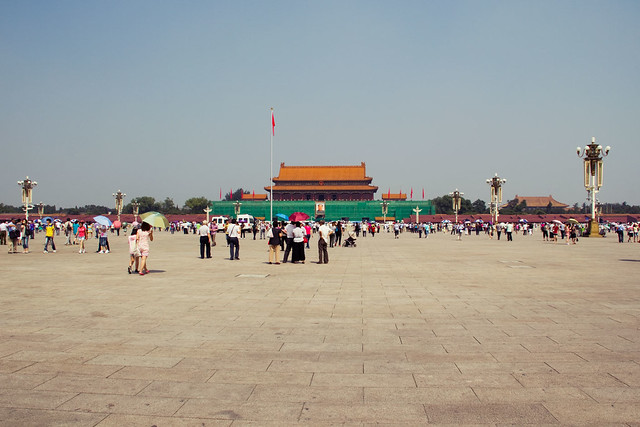
Our other big Beijing stop was Tiananmen Square, where a random Chinese guy insisted on taking his picture with us, solely because we were white people in China, and the Forbidden City, which was more impressive for its size and scope than the repetitive architecture.
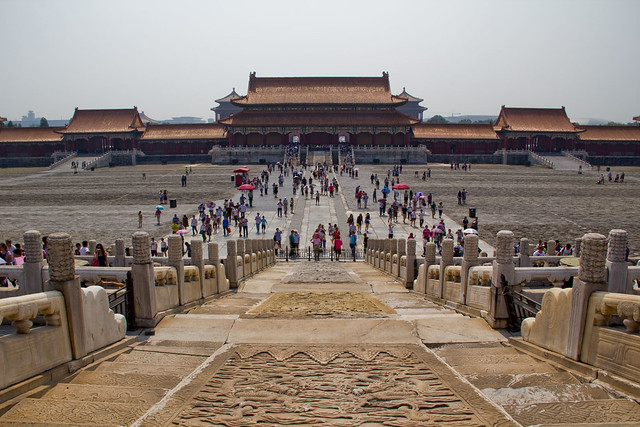
I can't speak for Andrea, but overall I left China with a much more positive impression than I was expecting to. The people and places were enjoyable more often than not, and much of the scenery we passed by was breathtaking. The government, on the other hand, was the source of some headaches, primarily in the form of the random bus inspections by the police and the (evadable) Internet censorship. Still, we were mostly left alone. Based on what I saw, I assume it's because the cops couldn't speak English and didn't want the hassle of dealing with us; the locals probably get it a lot worse than we did. The police intrusions got less and less frequent as we traveled further north, as well.
We rose early on our last morning in Beijing. After a brief subway ride, we arrived at the train station and boarded a train bound for Ulaanbataar, Mongolia, beginning the overnight climb into the desert steppes...
After crossing a weird no-man's-land bridge over a river and passing through customs, your entry point in China is Hekou, which was pretty squalid, albeit more developed than the Vietnamese town across the river. We had a hard time changing our money at banks because it was a Sunday; a helpful young policeman tried to find us a working ATM while practicing his broken English on me, but we were unsuccessful-- you could tell he was pretty bored and was mostly just looking for an excuse to get out of the office.
Finally, we found a guy at the bus station who was not only pretty fluent in English, but was also willing to change our money at what was a decent rate considering he was the only game in town that day. We boarded the bus bound for Kunming, and proceeded to experience 10 hours of driving through some pretty incredible scenery: elevated freeways through steep mountains, supported by impossibly tall columns and winding through endless tunnels. As we got approached Kunming, we came across some bizarre, unearthly rock formations and rows of spherical trees unlike anything I've seen before. It felt like we'd entered another planet after the endless jungles and hills in Vietnam and Cambodia. We later realized that what we were looking at was Kunming's star tourist attraction, the Stone Forest National Park.
Apart from that, Kunming doesn't have much to offer tourists, but the city was pretty incredible to us at the time. I'd never even heard of the place before we started planning the trip, but with a population of 6 million, it was much bigger than any other place we'd been to up to that point. The high elevation and dry climate allowed for mid-August temperatures in the 60s and 70s, a welcome relief from the nonstop sticky heat up until then.
The city center was mostly very clean and modern-- so much so that we almost felt like we were back in Japan. There were lots of genuine high-end retail shops, and a few convincing fake ones, too. We saw two of those imitation Apple stores that have been getting some attention in the West -- I presume they were both just different enough to avoid getting shut down.
Very soon, we discovered a very different language barrier than what we'd experienced before. Vietnamese and Cambodians almost always knew a little English (i.e., just enough to get you to buy something), but the Chinese we dealt with either could speak very well or knew none at all. Having learned some Japanese in our two years living in Kanazawa, we were in the unusual-for-Western-tourists position of being able to read and write some Chinese while having zero listening or speaking ability. This proved very helpful at many points where we could have easily gotten lost, and allowed us to try things we might not have otherwise tried, but the differences between the languages sometimes made for some confusion and frustration.
Our next stop was Chengdu, and our plans to take a sleeper train out of Kunming were foiled by the mad rush of high tourist season. Our knowledge of Chinese characters allowed us to figure out that all train seats on the route we wanted were completely booked for the next 10 days. We ended up finding a company that sold us tickets for a sleeper bus, which did allow us to lay down for the night, but it was cramped, stuffy, and didn't allow you to wear your shoes anywhere inside, even on the floor of the urine-soaked squatter toilet.
Finally in Chengdu, we found another modern, relatively clean city, with hotter temperatures than Kunming, but also with a fantastic subway line that had just opened a year earlier, which clearly had borrowed liberally from the design of Singapore's own modern, efficient metro system. Chengdu is the largest city in Sichuan (also romanized as Szechuan) province; if you've heard of or tried this ultra-spicy brand of southern Chinese cuisine, this province and its capital city are the epicenter.

First up on our tourism docket was the Leshan Grand Buddha, the largest carved stone Buddha statue in the world, and, completed in 810 AD, the largest pre-modern statue in the world. With the help of a nice college student who was majoring in English at Chengdu University and happened to be returning home to Leshan on the same bus we were taking, we made it there and back entirely on public transit.

The Grand Buddha is probably the only tourist site on our trip so far that was actually bigger than I had anticipated. It was carved into the side of a mountain at the banks of a river, and required a pretty steep hike down and up to get down to the Buddha's feet, where we took the requisite pictures alongside to give an idea of the full scale of the thing.

Our other big stop in Chengdu was the Panda Research Center, where we met a fellow American, a Vermonter named Alex who is living in China and speaks the language pretty well, much to our benefit. The center had 4 or 5 red pandas, who were playing and scurrying outside, and perhaps a dozen Giant pandas, who dislike the heat so much that they prefer to laze about in the cramped (but air-conditioned) indoors in the summer, despite the enormous outdoor enclosures they had access to.

The most memorable sight was the dozen or so baby pandas, all born in the past three weeks, who were being kept in incubators to ensure their survival in the tough early months. We weren't allowed to take pictures of these guys, and it's just as well, because as infants they resemble shaved molerats and had a few more months before they grew enough hair to become recognizably panda-like.

After Chengdu, we were stuck with another bus ride to Xian, during which a very stern lady attendant vigorously enforced the no-smoking policy with what amounted to a public shaming (which didn't stop the same guy from trying to light up two more times during the night, each time resulting in the lights being turned on and a few more minutes of arguing). Xian was a lot more like the China I was originally expecting-- hot, loud, dirty, congested, and (less expected) unrelentingly dusty, so much so that we came back caked in a layer of dust every time we ventured outside our hostel.

Xian was our base point for seeing the Terracotta Army. Our experience there was a little anticlimactic; not knowing any better, we first entered the first of three buildings, which contained the iconic pits with hundreds of warriors lined up. It was pretty big, but nowhere near what we'd imagined, so we figured the other two buildings had something more impressive. Wrong! Those were mostly just huge empty pits they'd already removed the soldiers from. Apparently the excavation is ongoing-- check back in a few years and they'll have a lot more soldiers lined up.

We were finally able to secure a sleeper train for our trip to Beijing, but it required us to spend three extra nights in Xian, whose dirt, heat, and grime started to wear out their welcome. Our 100+ year old hostel was nice enough, but apart from a dollar store with some hilarious knock-off products ("Horseman" razors, modeled after Gillette, and not Crest, but "Craot" toothpaste), Xian didn't have much going for it besides terrible air quality, horribly congested traffic, and a still-incomplete subway that was months away from being usable.
Finally, we got on the nicest non-Japanese train we'd ridden thus far, and arrived the next morning in Beijing, a city whose municipality is roughly the size of Belgium, and as such would be underserved by the descriptor "sprawling". The city center is served by an excellent (if at times inconveniently located) subway system that connected our hostel's area, a cute neighborhood centered around a large Buddhist temple, and the city's main shopping and business districts.

Our first full day was spent on a Great Wall excursion. The section we went to was slightly less packed with tourists and vendors than the famed section that Nixon (among others) had been photographed at. It did, however, boast a ski-style chairlift up to the steep mountaintop where the wall was located, and an exceedingly fun slide down the hill, where you pilot a little plastic seat with wheels and a single lever that functioned as both brake and accelerator.

Our other big Beijing stop was Tiananmen Square, where a random Chinese guy insisted on taking his picture with us, solely because we were white people in China, and the Forbidden City, which was more impressive for its size and scope than the repetitive architecture.

I can't speak for Andrea, but overall I left China with a much more positive impression than I was expecting to. The people and places were enjoyable more often than not, and much of the scenery we passed by was breathtaking. The government, on the other hand, was the source of some headaches, primarily in the form of the random bus inspections by the police and the (evadable) Internet censorship. Still, we were mostly left alone. Based on what I saw, I assume it's because the cops couldn't speak English and didn't want the hassle of dealing with us; the locals probably get it a lot worse than we did. The police intrusions got less and less frequent as we traveled further north, as well.
We rose early on our last morning in Beijing. After a brief subway ride, we arrived at the train station and boarded a train bound for Ulaanbataar, Mongolia, beginning the overnight climb into the desert steppes...
Thursday, August 25, 2011
Hoi An and Hanoi
After the modern excitement of Ho Chi Minh City, we caught the overnight train to Da Nang so we could enjoy the seaside. The coast was littered with condo and resort developments. It was often difficult to determine whether they were still under construction or already abandoned. We stayed in Hoi An, a historic port town with a nice beach. We used the hotel's free bikes to get to said beach. We happened to pass a vegan restaurant a woman was running out of her garage. It was buffet style and quite tasty. We also explored the old town area, which is very touristy but quiet and nicely preserved.

For dinner we walked a ways out to a very local vegetarian restaurant. They had a veganized version of the town's famous dish, a noodle bowl with various "pig" parts that uses special lye containing well water. It was delicious! They also had an amazing array of pre-packaged vegetarian faux meat including pig's ears and snails.
We took another overnight train up to Hanoi. By the time we got there we were quite exhausted. We were expecting the same shocking modernity as we found in Ho Chi Minh City, but Hanoi is still a bit more old fashioned. It's nearly impossible to find a cab that'll go by the meter, so you're forced to haggle for fares - a difficult task when you don't know the true distance. Our hotel was called the "Moonshine Palace." I don't think anyone's told them what moonshine means, at least to Americans. Initially, they put us in a top floor room. Then the rain started coming down fast, and it was falling equally fast through cracks in the ceilings! We showed them the inch of water pooling on the floor and they upgraded us to the "deluxe" room for free.
The problem with having to constantly haggle with people and the rising feeling you're constantly being scammed is that you occasionally end up being stand-offish or rude to the people who are actually being helpful. We went to the bus terminal to get a ride to Cuc Phuong national park and were immediately approached by a crowd of young men trying to sell us bus tickets. We assumed it was a scam, so we went straight to the ticket window. The woman wouldn't sell us a ticket and we couldn't figure out why. Eventually an English speaking woman came out from the back and said we should sit and someone would come sell us a ticket. We did as we were told, but we were still being repeatedly approached by the men we assumed were scammers. Eventually we figured out where the bus was and got on. Then one of the "scammers" got on and charged us the same standard fare as the locals. He ended up being pretty friendly even though we had basically blown him off a bunch of times in the station. As far as I can tell the buses are privately run but the station creates a standard fare, so the companies compete to get more customers.
When we arrived at the station it was time to have yet another adventure in haggling. I thought I had read that a motorbike ride from the station to the park was only 20,000 Vietnamese dong per person. It was pouring so we wanted a taxi. A guy told us he'd take us there for 300,000, which I said was ridiculous. He would only budge to 250,000, which we thought was still a major rip off. We finally give in, but instead of taking us to a cab he sits us down at his shop and he lights up a bong. He offered us some and I can only imagine what kind of scam he runs on tourists that agree. We're there fuming about having to wait for a cab we're overpaying for when we spot a real cab. Of course our "friend" angrily follows us and tells the cab to not take any less than 250,000. We demand 200,000. After much arguing we decide we'll just walk into town and have lunch. When we finally get away from our "friend" the cab drives up and says he'll do it for 200,000. The hilarious thing was that the park station then told us that 250,000 was pretty much the standard fare. It was the first and only time we managed to haggle in our favor, and it was a total accident!
At Cuc Phuong park we rented a lakeside bungalow and spent an energetic evening chasing mosquitos before finding the provided mosquito net. In southern Vietnam and Cambodia it typically only rained for three hours a day, but in the north it seems to rain all day and night and you get about three hours without it. This prevented us from really exploring the park, but we did enjoy the primate rehabilitation center, where we watched langurs and gibbons swing about and make some amazing loud noises. We also completed the steep and extremely slippery hike to the observation tower.

Vietnamese drivers are generally pretty crazy, but the one who took us back to the bus station should win some sort of prize. His method was to push the accelerator all the way down while continuously blaring his horn so that other drivers would get out of his way. He didn't understand that chickens don't know what a horn is, so we had a few near misses. At one point we came upon a man crouched in the middle of the road and our driver actually sped up. His only English was "only in Vietnam!" which he repeated gleefully every time he nearly pushed a scooter or cow off the road. He played us a bizarre radio program intended to teach Vietnamese children English using nursery rhymes. In one of the more surreal moments of my life, he swerved around a herd of cattle while we listened to girls with "The Shining" twins-like voices sing "Jack and Jill". Back in Hanoi, we actually had a hard time figuring out what to do. An incorrectly labeled Google Map prevented us from visiting the Ho Chi Minh mausoleum and seeing his actual body (which is only available in the morning). We did see the Ho Chi Minh Museum, which was rather odd. It has a lot of bizarre sculptures and cars crashing through walls that are supposed to represent Ho Chi Minh's ideas. Then it was an excellent dinner by the train station, and a train ride to the Chinese border.

For dinner we walked a ways out to a very local vegetarian restaurant. They had a veganized version of the town's famous dish, a noodle bowl with various "pig" parts that uses special lye containing well water. It was delicious! They also had an amazing array of pre-packaged vegetarian faux meat including pig's ears and snails.
We took another overnight train up to Hanoi. By the time we got there we were quite exhausted. We were expecting the same shocking modernity as we found in Ho Chi Minh City, but Hanoi is still a bit more old fashioned. It's nearly impossible to find a cab that'll go by the meter, so you're forced to haggle for fares - a difficult task when you don't know the true distance. Our hotel was called the "Moonshine Palace." I don't think anyone's told them what moonshine means, at least to Americans. Initially, they put us in a top floor room. Then the rain started coming down fast, and it was falling equally fast through cracks in the ceilings! We showed them the inch of water pooling on the floor and they upgraded us to the "deluxe" room for free.
The problem with having to constantly haggle with people and the rising feeling you're constantly being scammed is that you occasionally end up being stand-offish or rude to the people who are actually being helpful. We went to the bus terminal to get a ride to Cuc Phuong national park and were immediately approached by a crowd of young men trying to sell us bus tickets. We assumed it was a scam, so we went straight to the ticket window. The woman wouldn't sell us a ticket and we couldn't figure out why. Eventually an English speaking woman came out from the back and said we should sit and someone would come sell us a ticket. We did as we were told, but we were still being repeatedly approached by the men we assumed were scammers. Eventually we figured out where the bus was and got on. Then one of the "scammers" got on and charged us the same standard fare as the locals. He ended up being pretty friendly even though we had basically blown him off a bunch of times in the station. As far as I can tell the buses are privately run but the station creates a standard fare, so the companies compete to get more customers.
When we arrived at the station it was time to have yet another adventure in haggling. I thought I had read that a motorbike ride from the station to the park was only 20,000 Vietnamese dong per person. It was pouring so we wanted a taxi. A guy told us he'd take us there for 300,000, which I said was ridiculous. He would only budge to 250,000, which we thought was still a major rip off. We finally give in, but instead of taking us to a cab he sits us down at his shop and he lights up a bong. He offered us some and I can only imagine what kind of scam he runs on tourists that agree. We're there fuming about having to wait for a cab we're overpaying for when we spot a real cab. Of course our "friend" angrily follows us and tells the cab to not take any less than 250,000. We demand 200,000. After much arguing we decide we'll just walk into town and have lunch. When we finally get away from our "friend" the cab drives up and says he'll do it for 200,000. The hilarious thing was that the park station then told us that 250,000 was pretty much the standard fare. It was the first and only time we managed to haggle in our favor, and it was a total accident!
At Cuc Phuong park we rented a lakeside bungalow and spent an energetic evening chasing mosquitos before finding the provided mosquito net. In southern Vietnam and Cambodia it typically only rained for three hours a day, but in the north it seems to rain all day and night and you get about three hours without it. This prevented us from really exploring the park, but we did enjoy the primate rehabilitation center, where we watched langurs and gibbons swing about and make some amazing loud noises. We also completed the steep and extremely slippery hike to the observation tower.

Vietnamese drivers are generally pretty crazy, but the one who took us back to the bus station should win some sort of prize. His method was to push the accelerator all the way down while continuously blaring his horn so that other drivers would get out of his way. He didn't understand that chickens don't know what a horn is, so we had a few near misses. At one point we came upon a man crouched in the middle of the road and our driver actually sped up. His only English was "only in Vietnam!" which he repeated gleefully every time he nearly pushed a scooter or cow off the road. He played us a bizarre radio program intended to teach Vietnamese children English using nursery rhymes. In one of the more surreal moments of my life, he swerved around a herd of cattle while we listened to girls with "The Shining" twins-like voices sing "Jack and Jill". Back in Hanoi, we actually had a hard time figuring out what to do. An incorrectly labeled Google Map prevented us from visiting the Ho Chi Minh mausoleum and seeing his actual body (which is only available in the morning). We did see the Ho Chi Minh Museum, which was rather odd. It has a lot of bizarre sculptures and cars crashing through walls that are supposed to represent Ho Chi Minh's ideas. Then it was an excellent dinner by the train station, and a train ride to the Chinese border.
Monday, August 22, 2011
Saigon. Shit.* *(not actually shit)
We came into Vietnam with a little trepidation. Our friendly guesthouse proprietor in Phnom Penh had warned us that the Vietnamese tend to view outsiders solely as potential money sources ("wallets with legs" was the phrase he used). We weren't exactly sure what to expect when we got off the bus at Ho Chi Minh City (formerly Saigon-- the two names are still used interchangeably), but we were pretty surprised to find a modern but still-growing big city that wasn't all that different from Bangkok or Taipei. Compared to even the most developed parts of Cambodia, it was light years ahead in terms of infrastructure and amenities.
Not sure how to find our hotel, we asked a bank security guard for directions. He wasn't much help, but a passing guy on the street who spoke some English offered to show us the way. Turns out it was just around a corner and down an alley. Not only did he lead us straight to the hotel, he didn't even ask for anything in return. We didn't completely let our guard down, but it was kind of a relief to know that not everyone was going to take advantage of the disoriented tourists.
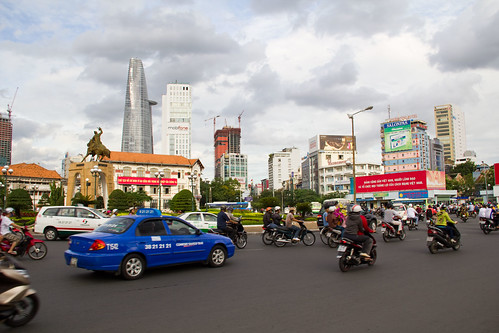
While HCM has more traffic lights with crosswalks than Phnom Penh, many crossings are of the uncontrolled, endless stream of motorbikes and cars variety. There is something of a method to the madness-- scooter drivers are surprisingly adept at weaving around pedestrians, which means you can (and pretty much have to) walk right out in front of oncoming traffic with some confidence that you won't end up in a neck brace afterward.
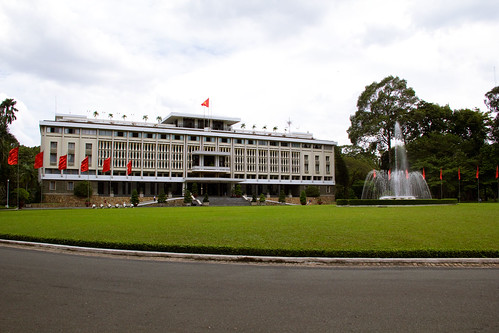
After getting settled, we set out for our first day of sightseeing. First up was the Reunification Palace, which was the official residence of the president of South Vietnam prior to the fall of Saigon. The building was of a neat mid-century-meets-traditional-Asian design, if a bit empty, but you did get to see things like the actual furniture, maps, and radio equipment they used during the war. There was also a pretty swanky roof patio, and a slightly creepy, labyrinthine basement that featured a lot of empty desks with decades-unused phones and radio equipment on them.
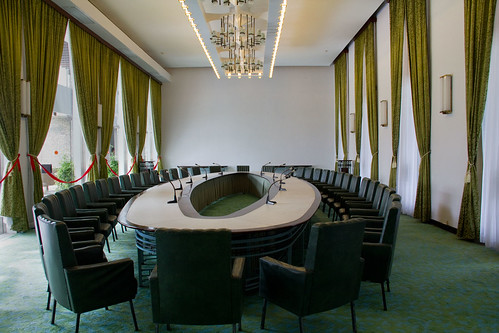


This was followed up by the nearby War Remnants museum, which featured some leftover American jets, helicopters and tanks on the outside, and some awful, depressing (if excessively slanted toward the North) pictures of the human effects of the war on the inside, including a wing specifically dedicated to picture of birth defects caused by Agent Orange, and glowing tributes to Americans and others who self-immolated in protest of US military involvement in the region. The most interesting part was an authentic reproduction of the brick prison cells and tiny barbed-wire cages that the South used to contain Northern POWs, which offered a mirror image to the infamous Hanoi Hilton torture techniques of the North.
After that fun bit of business, we checked out Ben Thanh market, which apart from some decent hand-painted reproductions of Tintin comic book covers, offered nothing but the same old parade of tacky t-shirts, handbags, and other tourist junk. That night, we enjoyed a fantastic meal at Saigon Vegan, which was one of several restaurants that catered to our diet in the city.
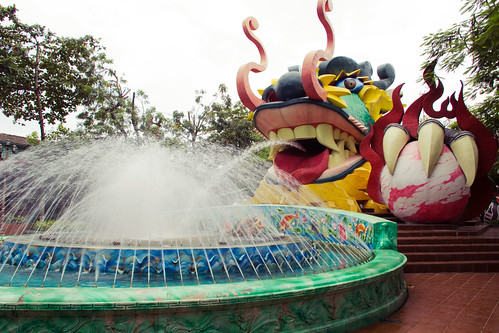
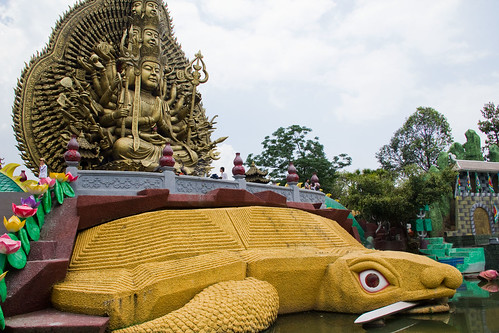
The next day, we took a long trek on a near-empty public bus to Suoi Tien theme park, which I think is one of the most bizarre places I've ever been to in my life. It's got standard theme park stuff-- roller coasters, laser tag, little kiddie rides, a water park with slides-- but everything is Buddhist themed, which came in the form of numerous shrines, giant statues depicting legendary creatures, and groups of visiting monks who apparently like to take in a roller coaster and snow cones from time to time.
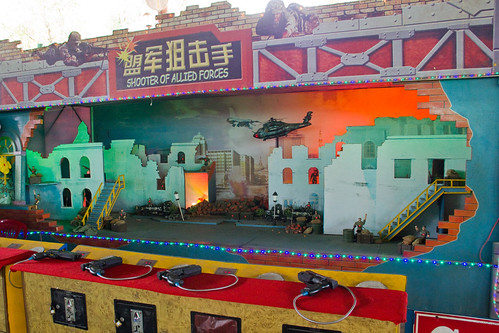
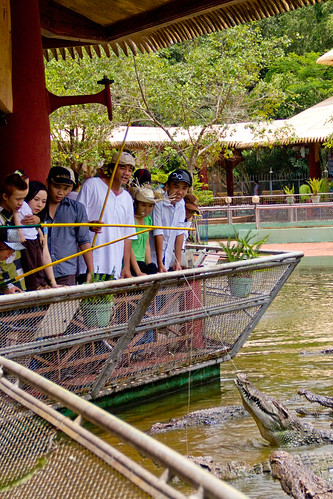
And did I mention the crocodile park? One of the big-ticket items at Suoi Tien was an elevated walkway above a pond with at least a hundred of those things staring out with their beady, dead eyes, in each tiny brain solely a lament of the existence of the metal barrier between it and the gawking meatbags taking photos from above. For a fee, you can tempt fate and feed them hunks of meat from a fishing pole. We declined, but watched a few others go for it. I couldn't tell you what's more terrifying-- the slow, mindlessly deliberate opening of the jaws when it sees a piece of meat in front of its face, or the deafening, heart-attack-inducing THUNK of the jaws suddenly closing at a million miles an hour.
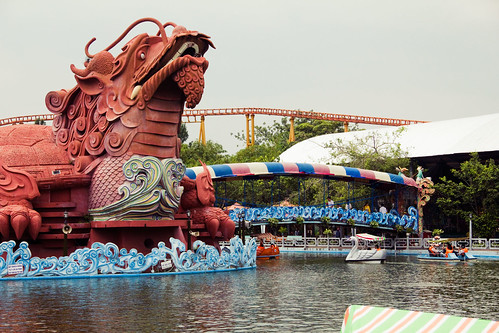
Leaving our reptile friends behind, we continued to one of the more interesting attractions at the park, called the Citadel. You cross a bridge to a building in the middle of a man-made lake, where you proceed to take a creaky old elevator down, leading into a pitch black hallway with faintly glowing arrows on the floor. Having gone in with no idea what it was supposed to be, we quickly realized it was some kind of odd haunted house, with a shaking floor, some crude animatronic monsters and gruesome still displays, and (best of all!) some guy who grabs at your ankles from a hidden booth underneath the floor. Can you imagine having that job-- waiting in a pitch black room in the middle of a pond just for some confused people to wander in so you can grab their ankles and freak them out?

Shortly before we decided to leave, while eating some much-needed fruit chip snacks before the long ride back to the city, this adorable, smiling old Vietnamese lady comes up to us out of nowhere. She must have assumed we were French, because she told me "Bon voyage, et a vos santes"-- have a good trip, and to your health-- which was by far the most use I've gotten from my four years of high-school French in a long time, as well as an unexpectedly warm and genuine gesture.
The next day, after a couple of rounds of bowling on the fourth floor of a trendy shopping mall just to kill some time, we boarded our sleeper train headed for Da Nang. We shared a room with a nice older Australian couple, who expressed relief that they wouldn't have someone noisy who they couldn't understand, but seemed understandably wary of the 30+ hour journey ahead of them, as they intended to continue all the way to Hanoi after we got off. I drifted off to sleep a few hours later.
And that was our Ho Chi Minh City experience! Andrea will pick things up from here with our (mis)adventures in Hoi An and Hanoi.
Not sure how to find our hotel, we asked a bank security guard for directions. He wasn't much help, but a passing guy on the street who spoke some English offered to show us the way. Turns out it was just around a corner and down an alley. Not only did he lead us straight to the hotel, he didn't even ask for anything in return. We didn't completely let our guard down, but it was kind of a relief to know that not everyone was going to take advantage of the disoriented tourists.

While HCM has more traffic lights with crosswalks than Phnom Penh, many crossings are of the uncontrolled, endless stream of motorbikes and cars variety. There is something of a method to the madness-- scooter drivers are surprisingly adept at weaving around pedestrians, which means you can (and pretty much have to) walk right out in front of oncoming traffic with some confidence that you won't end up in a neck brace afterward.

After getting settled, we set out for our first day of sightseeing. First up was the Reunification Palace, which was the official residence of the president of South Vietnam prior to the fall of Saigon. The building was of a neat mid-century-meets-traditional-Asian design, if a bit empty, but you did get to see things like the actual furniture, maps, and radio equipment they used during the war. There was also a pretty swanky roof patio, and a slightly creepy, labyrinthine basement that featured a lot of empty desks with decades-unused phones and radio equipment on them.



This was followed up by the nearby War Remnants museum, which featured some leftover American jets, helicopters and tanks on the outside, and some awful, depressing (if excessively slanted toward the North) pictures of the human effects of the war on the inside, including a wing specifically dedicated to picture of birth defects caused by Agent Orange, and glowing tributes to Americans and others who self-immolated in protest of US military involvement in the region. The most interesting part was an authentic reproduction of the brick prison cells and tiny barbed-wire cages that the South used to contain Northern POWs, which offered a mirror image to the infamous Hanoi Hilton torture techniques of the North.
After that fun bit of business, we checked out Ben Thanh market, which apart from some decent hand-painted reproductions of Tintin comic book covers, offered nothing but the same old parade of tacky t-shirts, handbags, and other tourist junk. That night, we enjoyed a fantastic meal at Saigon Vegan, which was one of several restaurants that catered to our diet in the city.


The next day, we took a long trek on a near-empty public bus to Suoi Tien theme park, which I think is one of the most bizarre places I've ever been to in my life. It's got standard theme park stuff-- roller coasters, laser tag, little kiddie rides, a water park with slides-- but everything is Buddhist themed, which came in the form of numerous shrines, giant statues depicting legendary creatures, and groups of visiting monks who apparently like to take in a roller coaster and snow cones from time to time.


And did I mention the crocodile park? One of the big-ticket items at Suoi Tien was an elevated walkway above a pond with at least a hundred of those things staring out with their beady, dead eyes, in each tiny brain solely a lament of the existence of the metal barrier between it and the gawking meatbags taking photos from above. For a fee, you can tempt fate and feed them hunks of meat from a fishing pole. We declined, but watched a few others go for it. I couldn't tell you what's more terrifying-- the slow, mindlessly deliberate opening of the jaws when it sees a piece of meat in front of its face, or the deafening, heart-attack-inducing THUNK of the jaws suddenly closing at a million miles an hour.

Leaving our reptile friends behind, we continued to one of the more interesting attractions at the park, called the Citadel. You cross a bridge to a building in the middle of a man-made lake, where you proceed to take a creaky old elevator down, leading into a pitch black hallway with faintly glowing arrows on the floor. Having gone in with no idea what it was supposed to be, we quickly realized it was some kind of odd haunted house, with a shaking floor, some crude animatronic monsters and gruesome still displays, and (best of all!) some guy who grabs at your ankles from a hidden booth underneath the floor. Can you imagine having that job-- waiting in a pitch black room in the middle of a pond just for some confused people to wander in so you can grab their ankles and freak them out?

Shortly before we decided to leave, while eating some much-needed fruit chip snacks before the long ride back to the city, this adorable, smiling old Vietnamese lady comes up to us out of nowhere. She must have assumed we were French, because she told me "Bon voyage, et a vos santes"-- have a good trip, and to your health-- which was by far the most use I've gotten from my four years of high-school French in a long time, as well as an unexpectedly warm and genuine gesture.
The next day, after a couple of rounds of bowling on the fourth floor of a trendy shopping mall just to kill some time, we boarded our sleeper train headed for Da Nang. We shared a room with a nice older Australian couple, who expressed relief that they wouldn't have someone noisy who they couldn't understand, but seemed understandably wary of the 30+ hour journey ahead of them, as they intended to continue all the way to Hanoi after we got off. I drifted off to sleep a few hours later.
And that was our Ho Chi Minh City experience! Andrea will pick things up from here with our (mis)adventures in Hoi An and Hanoi.
Subscribe to:
Posts (Atom)
